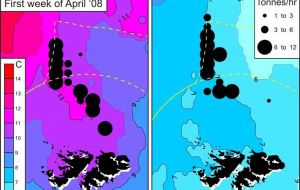MercoPress. South Atlantic News Agency
Falkland: Illex stocks hit the top for third year in a row
 Locations of illex catches
Locations of illex catches AS the saying goes, you can sometimes have too much of a good thing. High catches of illex taken in the Southwest Atlantic in the last two years flooded the world market and caused a significant drop in squid prices. Together with rocketing fuel costs many fishing companies have struggled to make their fishing profitable.
This is probably why only 44 jiggers applied for Falkland licenses this year, compared to 58 vessels last year. Consequently, license fees for 2008 amounted to about £4.6 million, meaning that the illex fishery has brought less money to the Falklands this year than the more successful loligo fishery. Continued global warming melts the Antarctic ice which in turn cools the Antarctic Circumpolar Current and its derivatives, such as the Falkland Current. This year the intensified Falkland Current brought cooler water to the Patagonian Shelf delaying southward migrations of squid from their spawning grounds in Uruguay and northern Argentina. Dense aggregations of migrating squid appeared on the High Seas only at the end of January. The international trawl fleet, including seven Falklands-registered trawlers fished for illex before the start of the first loligo season and had extremely good catches of 30- 50 tonnes per day. Squid were quite small and immature (18-20 cm mantle length), belonging to the Southern Patagonian Stock (SPS) that later should migrate to the Falkland waters. Catches by jiggers were about ten tonnes per night, as these small squid were less attracted by jig lures. The first schools of illex appeared in the north-western part of the FICZ in the last three days of February. Only four to 13 jiggers fished there, with catches ranging from 25 to 40 tonnes per night. The rest of the licensed jigging fleet preferred to fish on the High Seas in March, where the migratory squid accumulated before moving further south to Falkland waters. In the second half of March, only one to two jiggers remained in Falkland Zones to monitor the fishing situation. A real breakthrough in the ilex fishery happened in the last few days of March, two weeks later than last year. Squid finally started their movement to Falkland waters and the remaining lucky couple of jiggers saw catches peaking at 50-70 tonnes per night. The next day, 14 vessels returned to FICZ and had average catches of up to 65 tonnes per night (maximum 93 tonnes per night). The majority of the jigging fleet operated in the vicinity of the gradient zone between the Falkland Current and shelf waters in the northwest of FICZ. The catches were stable in April averaging 50 tonnes per night and decreasing to 25-30 tonnes per night only during six days of stormy weather. In the second half of April, some jiggers had as much as 108 to per night. At every moment, only 28-35 of 42 vessels were fishing with the rest of the fleet transhipping in Berkeley Sound. The sea surface cooled from 8°C down to 7°C during May, revealing a negative anomaly in water temperature. These environmental conditions caused the late maturing group of squid (LSPS) to migrate from the Argentine EEZ to the continental slope much further north than usual. Fortunately for the Falkland fishery, the migratory route of prespawning squid passed through the very northern part of the outer conservation zone (FOCZ - 48- 48°30'S), and the jigging fishery took place mainly in that region. During the first two weeks of May, the whole jigging fleet had excellent catches of 60-65 tonnes per night, with a maximum of 131 tonnes. Then, the majority of vessels moved to the High Seas, and Taiwanese jiggers stayed there until the end of the month. Korean jiggers (22-24 vessels) returned to the northern part of FOCZ on May 26 and again had high and stable catches of illex (60 tonnes per night). Massive migrations of the LSPS squid carried on during the first ten days of June. The whole jigging fleet (including returning Taiwanese jiggers) fished in a small region of 48° - 48°30'S, having unprecedented catches of 38 mt per night. Between June 10 and 15, the LSPS squid finally left the Falkland waters heading further north to spawn, and catches dropped to a mere 2-3 tonnes per night. It should be noted that due to colder than usual feeding season in February-May 2008, squid had slower growth and attained only 30 cm modal length (700 g in weight), comparing to 33 cm (900 g) in a usual year. The fishing season closed as planned on June 15 with a total ilex catch of 106,181 tonnes. Despite the smaller catch (albeit caught by smaller number of vessels), the ilex fishing season 2008 of appeared to be one of the best seasons in terms of squid abundance. This gives us a hope that market demands for this protein-rich resource will reverse their negative trends and attract more potential customers to exploit it next year. Penguin News By Alexander 'Sasha' Arkhipkin,Senior Fisheries Scientist FIFD



Top Comments
Disclaimer & comment rulesCommenting for this story is now closed.
If you have a Facebook account, become a fan and comment on our Facebook Page!